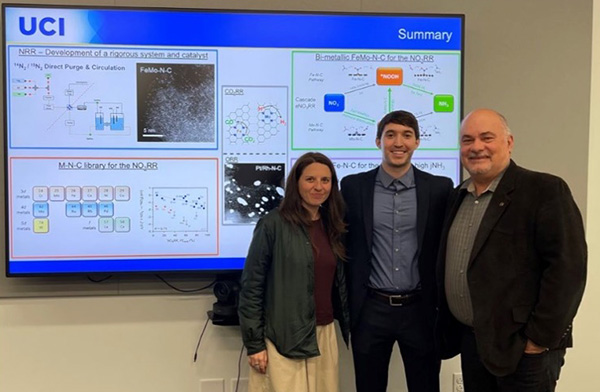Cooling Down the Chemical Industry

Aug. 21, 2023 - If wind turbines and electric vehicles are icons for green energy and transportation, perhaps it’s time to find one for industry and agriculture too, as they account for over a third of the globe’s carbon footprint.
“Addressing the decarbonization of ammonia is just as important as making all the buses electric,” says UCI Chancellor’s Professor of chemical and biomolecular engineering Plamen Astanassov. That’s because ammonia is a key component of fertilizer, which is used in about half of the world’s production of food.
In their recent paper in the journal Nature Communications, Astanassov and UCI doctoral student Eamonn Murphy describe their breakthrough in creating a methodology to produce chemicals by electrifying them rather than heating them.
In their experiment, reactants (nitrates) were converted at the cathode, which is the electrode where electrons are acquired from the external circuit. Electricity was then supplied between the two electrodes: the anode and cathode. The electrodes at the cathode broke the chemical bonds between nitrogen and oxygen in the nitrates and replaced the oxygen with hydrogen to form ammonia.
They used this methodology to achieve the complex synthesis of ammonia from waste nitrate in a carbon neutral manner. Their lab focused on the electrosynthesis of ammonia, a key element in the globe’s agricultural industry, but the process is applicable to a wide range of materials.
Murphy made 14 individually atomically dispersed materials, at least six of which were reported for the first time. He demonstrated their reactivity in ammonia synthesis, thus showing that a variety of catalytic syntheses could be achieved through electrification.

Products in the chemical industry are usually created through thermal catalytic synthesis. Atanassov’s lab has provided a new process to achieve chemical synthesis without the heat and carbon emissions.
This electrocatalytic method can also be used in fuel cells, electrolyzers and electrosynthesis technology.
“This is the opportunity to decarbonize the chemical industry,” Astanassov said, “to turn the chemical industry to room temperature.”
The team collaborated with the Fritz Haber Institute in Berlin. Their research is supported by the U.S. Department of Energy and the National Science Foundation.
Their electrocatalytic approach is opening up a cooler path for industry and agriculture.
- Natalie Tso
